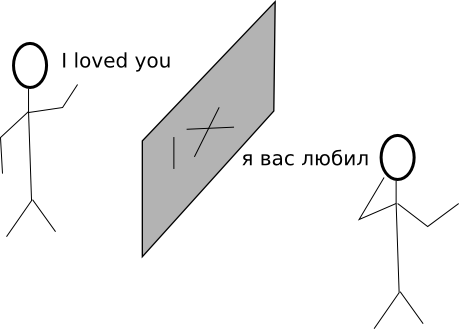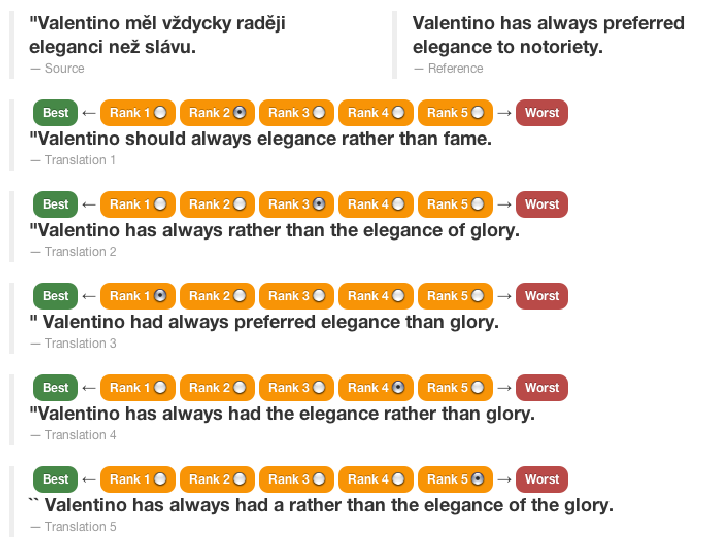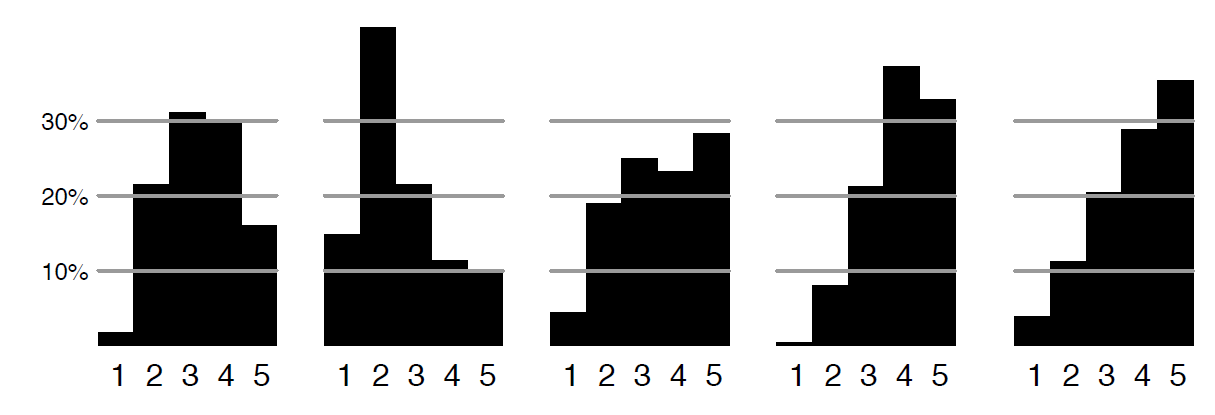1. Words, and other words
A brief introduction to machine translation
Machine Translation covers a wide range of goals
- From FAHQUMT
- Fully Automatic High Quality Unrestricted MT
- To MAHT
- Machine-Assisted Human Translation
- FAHQUMT remains a dream: but hope springs eternal
- MAHT is big business, but not of much theoretical interest
The contrast between hyped-up promises of success and poor actual
performance led to
- The ALPAC report (1966)
- Found that many years of research had failed to meet expectations
- USA has no shortage of translators
- Fully automatic MT doesn’t really work, quality hasn’t improved much
- it isn’t clear if it will ever work
“The Committee indeed believes that it is wise to
press forward undaunted, in the name of science, but that the motive
for doing so cannot sensibly be any foreseeable improvement in
practical translation. Perhaps our attitude might be different if
there were some pressing need for machine translation, but we find
none.”
- The end of substantial funding for MT in the US for nearly
20 years
2. From knowledge-rich to machine-learning
MT has followed the same trajectory as many other aspects of speech and
language technology
- Historically, MT systems were based on one or more levels of linguistic analysis

- The largest and most heavily used MT system in the world worked like
this until very recently
- SYSTRAN, used by the EU to help with its translation load of over 2
million pages a year
- But most MT work today is based on one form or another of noisy channel decoding
- With language and channel models being learned from corpora
3. Before his time: Warren Weaver
Stimulated by the success of the codebreakers at Bletchley Park
(including Alan Turing), Weaver had an surprisingly prescient idea:
[...] knowing nothing official about, but having guessed and inferred
considerable about, powerful new mechanized methods in cryptography. . .one naturally wonders if
the problem of translation could conceivably be treated as a problem
in cryptography. When I look at an article in Russian, I say: “This
is really written in English, but it has been coded in some strange
symbols. I will now proceed to decode.”
Have you ever thought about this? As a linguist and expert on
computers, do you think it is worth thinking about?
from a letter from Warren Weaver to Norbert Wiener, dated April 30, 1947
4. A very noisy channel
Applying the noisy channel model to translation requires us to stand
normal terminology on its head
- Usually we talk about source and target languages
- For example, when translating Братья Карамазовы into English
- Russian is the source
- English is the target
But from the perspective of the noisy channel model
- The source is English
- The channel distorts this into what we see or hear, that is, Russian
- Which we have to decode
- to get to the source
- which is the target
- :-)

5. Priors and likelihood for MT
Remember the basic story (using e for English and
r for Russian):
The prior is just our old friend, some form of language model
But the channel model needs to be articulated a bit for translation, in several ways
- The source and target need not have the same number of words
- And the mapping part, on even a fairly simple view, has to do
two things:
- Not just translate the words
- But re-order them as well
So we need a channel model that takes all of these into account
6. Translation modeling for MT
J&M 2nd ed. Chapter 25 takes you through a step-by-step motivation for the
first successful attempt at doing things this way
- By the IBM team, working from French into English
- Using Canadian Hansard for training and testing
- And a variety of HMM-based decoding methods
All their approaches start with a formal notion of alignment
- A (possibly one-to-many) mapping from source word position to
position in the observation sequence
- So, for our trivial Russian example, this would be
1 3 2 - Because the second and third words exchange positions between English
and Russian

7. Translation modelling, cont'd
Their simplest model then has three conceptual steps:
- Choose a length for the Russian, given the length of the English
- Remember, from the model's perspective we are generating the
Russian observation, starting from the English source
- Think of the POS-tagging HMM
- Which 'generates' English words (the observations) from a sequence
of POS tags (the source)
- Choose an alignment from the words in the source (English) to the
words in the observations (Russian)
- For each position in the Russian, choose a translation of the English
word which aligns to it
Following simplifying assumptions of the usual Markov nature, we end up
with
Where
- I and J are the (observed) length of the
English and the (hypothesised) length of the Russian, respectively
- is
the alignment of the jth Russian word
For the translation model before we do the Bayes rule switch
and the argmax
8. Contemporary MT
We've barely scratched the surface
But state-of-the-art MT systems today all derive from essentially this
starting point
- Including Google Translate
- Which used to think that "я вас любил" should be translated as
"I loved you more"
- Of course it's clearer in the context of the whole Pushkin poem from
which the phrase is extracted
9. Getting started: The role of data
Broadly speaking, we have two models to learn:
- We've seen this already,
- Target
language data
- I.e. monolingual
- Lots of it
- Such as Google's Gigaword corpus
- For word-word alignment and word/phrase translation
- Bilingual
- Harder to get lots

10. Getting started: segmentation and sentence alignment
Just as with other corpora, we need to pre-process the raw materials
- Normalise markup
- Check for and correct character encoding problems
- Segment and normalise
- tokens
- morphemes?
- sentences
- paragraphs
- down-case at beginning of sentences, maybe
- tag
These will vary in difficulty given the form of the raw data
- And the language involved
But for the translation model, with respect to the bilingual data, we need more
- We need to align the two versions at the paragraph and sentence level
- Sentence level is not always 1-to-1
11. Sentence alignment details: Gale and Church (1993)
Assumptions:
- We start with two documents
- In source and target languages
- Translations of one another
- Sentence order is rarely if ever changed
- If paragraphs exist, they are already aligned
Paragraph by paragraph, the algorithm matches source sentences to zero, one or
two target sentences
- Sentence may be deleted by translator
- Sentence may be split into two by translator
- In either direction
- We don't actually always know which was the original
12. Gale and Church, cont'd
Start with some empirical observations:
What does a hand-aligned corpus tell us about sentence alignment?

- That gives G&C the basis for a maximum likelihood estimate of
- Where by match is meant a particular alignment choice
What about relative length?
- If we suppose lengths (in characters) are
normally distributed around equality
- With standard deviation estimated from the same hand-aligned corpus
- We get this picture when we plot the actual z-scored ratio

From this kind of data G&C get what they need to feed into a dynamic programming search
for the optimal combination of local alignments within a paragraph
- Source sentences on one edge
- Target along the the other
- Dynamic programming in this case is similar to spelling correction
- With costs coming from the formula above, drawing on six
possible 'moves'
- deletion, insertion, substitution
- two-for-one, one-for-two, two-for-two
13. Evaluation-driven development
From 2006–2014, an annual competition was held
- The 'Workshop' on Statistical Machine Translation (WMT)
Shared task, many language pairs
- Participants given corpora with which to train their MT systems
- They get a test set to translate and submit
- Submissions are scored
- Participants write papers on how they built their systems for the conference
14. Evaluation
How can we evaluate systems?
As with other similar tasks, in one of two ways:
- Extrinsic evaluation
- Measure the utility of the
result with respect to some (real) use
- As first step in HQ production: how much post-editing required?
- Comprehension tests
- As basis for search or information retrieval: measure quality of
that result
- Intrinsic evaluation
-
Measure the quality of the result against some (more-or-less
explicit) standard
- Human quality assessment
- Automatic comparison to gold standard
Any measure involving humans is
- Slow
- Expensive
- Hard to ensure fairness
- Not stable
- Judges disagree with each other
- And with themselves (from one trial to the next)
Any automatic measure is
- Only as good as the gold standard it uses
- Misleading if based on a single translation: there is no one 'right' answer
15. Human evaluation
One or more judges, working from
- MT system output
- Original
- Reference translation(s) (maybe)
Different dimensions for judgement
- How well is the meaning of the source preserved?
- How fluent is the result in the target language?
Typically judged on a numeric scale
- Which is misleading
- You can not treat the results as numbers
- That is, you can't compute mean, variance, etc.

As mentioned before, agreement can be a problem

16. Automatic evaluation
There was no accepted automatic evaluation measure for MT for a long time
- A problem given the evaluation-driven funding ideology
- Single-reference an obvious problem
The advent of the BLEU methodology (BiLingual Evaluation
Understudy) around 2000 helped a lot
- By Papieni and colleagues at IBM T. J. Watson Labs
It correlates surprisingly well with human judgements
- Although it's nowhere near perfect
- It's good enough at least for now
17. A digression about headroom
When you need numerical scores to facilitate hillclimbing
- It really matters how far you are from your goal
If your system is doing pretty well already
- You need a very accurate measure to reliably detect improvement
But if you're doing pretty badly
- A rough-and-ready measure will be just fine
So we can ask "How much headroom do we have?"
- MT has plenty of headroom
- Thus the remark above that BLEU is "good enough for now"
18. BLEU: overview
BLEU starts from the observation that just getting the 'right' words
counts for a lot
- But goes beyond that some way towards checking that they're in the
'right' order
- And allows for multiple reference translations
So BLEU counts not just word overlap
between candidate output sentence and reference translation(s)
Two parts to the evaluation of each sentence:
- Modified precision score for n-grams of size 1 to 4
- A penalty for short translations
- Essentially a recall measure
Combined over paragraphs or documents
19. A digression about precision and recall
To test the overlap between two sets
- Results for a document retrieval request vs. the 'correct' set
- Word boundaries hypothesised for a Chinese sentence vs. the ones actually there
- Words in a candidate translation vs. words present in the union of a
reference set of translations
We need to answer two questions
What proportion of the answers are right?
- That's precision
What proportion of the truth was found?
- That's recall
You need both
- A system which makes one and only one guess, and gets it right
- has
100% precision
- but very low recall
- And one which guesses the whole lexicon every time
- has 100% recall
- but very low precision
20. BLEU: Three versions of the formula
As described, the BLEU formula is a product
- Of the brevity penalty
- Where c is the number of words in the candidate
- And r is the number of words in the reference
- And the geometric mean of the modified ngram precisions
- where
The 4th root is usually expressed via the log domain
- As this allows non-linear weighting if desired
- Where is the weight per contribution of the different n-grams
- Usually a constant
The whole thing is usually then moved into the log domain
- For simplicity in presentation, as well as the usual practical reasons
See J&M 2nd ed.
25.9 for details and a worked example
21. Getting something to evaluate: Back to translation modelling
How do we learn even the simple model we sketched last time?
We saw how to align sentence (groups) between parallel corpora
- But how do we learn the components of the translation (channel) model?
- That is, the probabilities for the (word) alignment function and the
word-word translations
From the 20,000-foot level, this is similar to the HMM-learning problem
for tagging
- For which the answer was the forward-backward algorithm
That is, we start out with nothing
- That is, we initialise the translation model with either random, or uniform, estimates of probability for all
possible alignments and all possible translations
- Well, not all possible translations
- We'll assume that we have at least the beginnings of a bilingual lexicon
Then, very much as in the forward-backward algorithm
- We'll 'count' what happens with every sentence pair in our aligned corpus
- When we match them using our current model
And use those counts to re-estimate all the probabilities
22. Expectation maximisation
What's common to the approach just described and the forward-backward
algorithm is that they're both examples of expectation maximisation
- Adjusting a model repeatedly until what it sees most often
- Is what it 'expects' to see most often
How can this possibly work?
- Just as with forward-backward
- The data will help

As we iterate over the data, we will 'count' la being
realised as the more often than anything else
- Giving us something like this

- And the effect of this helps with other things in turn

What happened with 'fleur' is called the pigeon hole principle
- There's nowhere else plausible for it to map to
23. But this is all changing
Over the last two years, there's been a huge shift in emphasis
- Away from the explicit noisy channel model architecture
- With multiple components
- Carefully trained, weighted and combined
- To deep neural nets
- Which may have several components
- But may not overtly distinguish the channel model from the language model
Google announced a few months ago that Google Translate had made such a shift for some of
the most common language pairs
24. Expectation maximisation, cont'd
By aggregating across all sentence pairs, we can count how much
probability attaches to e.g. the bleu/blue pair, compared to
all the bleu/... pairs, to get a new ML estimate
In the simplest IBM model, so-called IBM Model 1,
they started with the assumption that all alignments were equally likely
The overall shape of their EM process was as follows
- Step 1: Expectation
- For every sentence pair
- For every possible word alignment
- Use the word-word translation probabilities to assign a total probability
- Step 2: Maximisation
- Suppose the assigned values to be true
- Collect probability-weighted counts for all word translation pairs
- Re-estimate the probabilities for every pair
Iterate until convergence
- That is, go back to Step 1 and use the re-estimated word-word probabilities to re-estimate the alignment probabilities
In IBM's first efforts (IBM Model 1)
- training (and testing) on Canadian Hansard
- With no probabilities being learned for the individual word alignment mappings
This approach performed well enough to launch a revolution
25. Expectation maximisation: simplified example
[Modelled on J&M section 25.6.1 (q.v.) (in turn based on "Knight, K.
(1999b). A statistical MT tutorial workbook. Manuscript prepared for the 1999
JHU Summer Workshop.")]
Assume one-to-one word alignments only
So we have
Where
- A is an alignment
- F is a foreign
sentence
- E is an English sentence
- J is the length
of the foreign sentence
- and the English, given our assumption
- t is a conditional word translation probability
And just two pairs of sentences
- "black cat":"chat noir"
- "the cat":"le chat"
Giving the following vocabularies:
26. EM Example, cont'd
We start with uniform word translation probabilities
| t(chat|black)=1/3 | t(chat|cat)=1/3 | t(chat|the)=1/3 |
| t(le|black)=1/3 | t(le|cat)=1/3 | t(le|the)=1/3 |
| t(noir|black)=1/3 | t(noir|cat)=1/3 | t(noir|the)=1/3 |
Do the Expectation step: first compute the probability of each possible
alignment of each sentence:

Normalise P(a,f|e) to get P(a|f,e) for each
pair by dividing
by the sum of all possible alignments for that pair

Finally sum the fractional 'counts' for each pair and each source
| tcount(chat|black)=1/2 | tcount(chat|cat)=1/2 + 1/2 | tcount(chat|the)=1/2 |
| tcount(le|black)=0 | tcount(le|cat)=1/2 | tcount(le|the)=1/2 |
| tcount(noir|black)=1/2 | tcount(noir|cat)=1/2 | tcount(noir|the)=0 |
| total(black)=1 | total(cat)=2 | total(the)=1 |
The maximisation step: normalise the counts to give ML estimates
| t(chat|black)=1/2 / 1 = 1/2 | t(chat|cat)=(1/2 +
1/2) / 2 = 1/2 | t(chat|the)=1/2 / 1 = 1/2 |
| t(le|black)=0 / 1 = 0 | t(le|cat)=1/2 / 2 =
1/4 | t(le|the)=1/2 / 1 = 1/2 |
| t(noir|black)=1/2 / 1 = 1/2 | t(noir|cat)=1/2 / 2 =
1/4 | t(noir|the)=0 / 1 = 0 |
All the correct mappings have increased, and some of the incorrect ones
have decreased!
Feeding the new probabilities back in, what we now see for each alignment is

And the right answers have pulled ahead.













